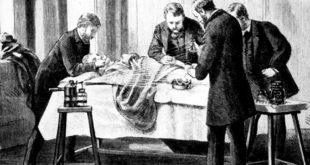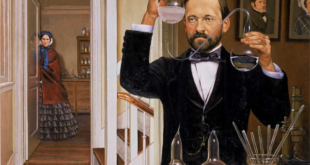
Proving the germ theory of disease was the crowning achievement of the French scientist Louis Pasteur. He was not the first to propose that diseases were caused by microscopic organisms, but the view was controversial in the 19th century, and opposed the accepted theory of “spontaneous generation”.
Pasteur set out to understand the fermentation process, and soon realized that alcohol in wine was produced by yeast which lived on the skins of grapes. During fermentation the yeast appeared healthy and budding under a microscope, but lactic acid was formed and the wine turned to vinegar when other microbes were seen among the yeast cells. Further analysis of the wine showed a number of complex organic molecules, some of which were able to rotate light, a property of compounds produced by living organisms. Through several experiments Pasteur showed that fermentation required contact with dust in the air.
Pasteur then turned his attention to the health of silk worms, which produced silk for the cloth industry. He discovered that he found that healthy silk-worms became ill when they nested in the bedding of those suffering from disease. In this study Pasteur found that environment directly affected contagion, and that the spread of disease could be controlled by sterilization. His studies on yeast had shown that microbes could be air-borne, and he realised that these two studies could be directly applied to the transmission of disease in humans. He spoke on the subject at The Academy of Medicine in Paris, and although his radical ideas were only accepted by a few physicians, his recommendations saw the introduction of sterile surgical techniques.
Final proof of germ theory came when Pasteur was able to grow the anthrax bacillus in culture. Although anthrax had been isolated by Robert Koch, opponents believed that the spores he found could have been contaminants in his culture medium. Pasteur placed a drop of blood from a sheep dying of anthrax into a sterile culture, and allowed the bacilli to grow. He repeated this process until none of the original culture remained in the final dish. The final culture produced anthrax when injected into sheep, showing that the bacillus was responsible for the disease.
 Pasteur Brewing Louis Pasteur – Science, Health, and Brewing
Pasteur Brewing Louis Pasteur – Science, Health, and Brewing 


